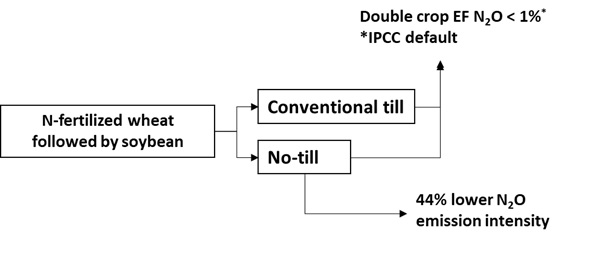Soil nitrous oxide emissions from a soybean-wheat succession under different tillage systems in Southern Brazil
29/Mar/2023
ABSTRACT No-tillage (NT) has been largely adopted in Brazil as a strategy for soil conservation, but for the last decade, there have been governmental incentives for its adoption arising from its potential for soil C accumulation. Notwithstanding, the soil mulch formed from crop residues favors the maintenance of soil moisture and nutrients in the upper soil layers, which stimulates soil microbial activity and may increase the potential for nitrous oxide (N2O) emissions. In addition, double-cropping systems in the same year […]
Daycent Simulation of Methane Emissions, Grain Yield, and Soil Organic Carbon in a Subtropical Paddy Rice System
18/Jun/2018
ABSTRACT The DayCent ecosystem model, widely tested in upland agroecosystems, was recently updated to simulate waterlogged soils. We evaluated the new version in a paddy rice experiment in Southern Brazil. DayCent was used to simulate rice yield, soil organic carbon (SOC), and soil CH4 fluxes. Model calibration was conducted with a multiple-year dataset from the conventional tillage treatment, followed by a validation phase with data from the no-tillage treatment. Model performance was assessed with statistics commonly used in modeling studies: […]
Methane fluxes from waterlogged and drained Histosols of highland areas
01/Apr/2014
Soil can be either source or sink of methane (CH4), depending on the balance between methanogenesis and methanotrophy, which are determined by pedological, climatic and management factors. The objective of this study was to assess the impact of drainage of a highland Haplic Histosol on CH4 fluxes. Field research was carried out in Ponta Grossa (Paraná, Brazil) based on the measurement of CH4 fluxes by the static chamber method in natural and drained Histosol, over one year (17 sampling events). […]
Methane efflux in rice paddy field under different irrigation managements
01/Apr/2013
Paddy rice fields may contribute to methane (CH4) emission from soil due to anaerobic conditions after flooding. Alternatives to continuous flooding irrigation in rice have been developed to mitigate CH4 efflux into the atmosphere. This study aims to investigate the effects of irrigation managements in the CH4 efflux during the rice growing season. An experiment was carried out at in Santa Maria, Rio Grande do Sul State, Brazil, during 2007/08 and 2009/10 growing seasons. The treatments were continuous flooding and […]

